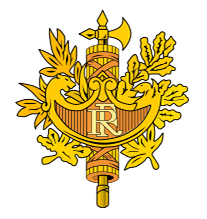France: Government
Key Figures
- Chief of State:
- President Emmanuel Macron
- Head of Government:
- Caretaker Prime Minister Gabriel Attal
Overview
- Government Name:
- French Republic
- Constitution:
- Adopted: 1958; French constitution establishes France as a secular and democratic country. It allows for the ratification of international treaties, especially those related to the European Union, and describes the methods for its amendments.
- Government Type:
- Republic

Index of Economic Freedom
Country Risk Rating
Government Branches
| Main Powers | Election Process | Election Cycle 1 | |
|---|---|---|---|
| Executive | The president appoints the prime minister and cabinet and, if from the same political side, he can ask for him to resign upon demand. The prime minister may issue autonomous or subordinated regulations. |
The president is elected by absolute majority vote through a two-round system. The prime minister is appointed by the president. |
5 years |
| Judicial | The constitutional council is elected by the president and parliament. The independent judiciary system does not answer to, and is not controlled by, the other two branches of government. |
Court of cassation judges are appointed by the president of the republic from nominations from the high council of the judiciary, presided by the court of cassation and 15 appointed members. 3 constitutional council members are each appointed by the national assembly and senate presidents and another 3 are appointed by the president of the republic. |
Court of Cassation no term limit; Constitutional Court: 9 years |
| Legislative | The national assembly has the power to force the resignation of the executive cabinet by a vote. Both the senate and assembly contain committees that write reports and can establish parliamentary inquiry commissions with broad investigative power. |
The national assembly has 577 members elected by absolute majority vote in single-member constituencies. The senate has 348 members who are indirectly elected by an electoral college. |
National Assembly: 5 years; Senate: 6 years |
Regional Trade Blocs
International Organization Participation [2]
Environmental Agreements [3]
Tax Information [2]
- Tax Authority:
- French Ministry of Finance
- Tax Name:
- VAT
Sources:
- ElectionGuide http://www.electionguide.org/
- EY, http://www.ey.com
- CIA World Factbook, https://www.cia.gov/the-world-factbook/
- U.S. Bilateral Relations Fact Sheets http://www.state.gov/r/pa/ei/bgn/


